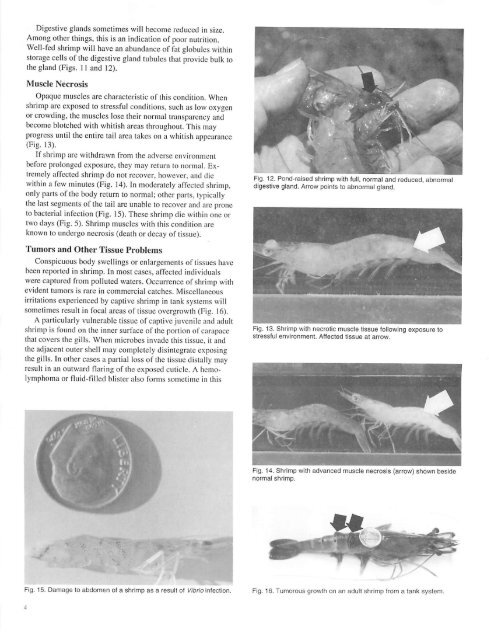Handbook of Shrimp Diseases - the National Sea Grant Library
Handbook of Shrimp Diseases - the National Sea Grant Library
Handbook of Shrimp Diseases - the National Sea Grant Library
Create successful ePaper yourself
Turn your PDF publications into a flip-book with our unique Google optimized e-Paper software.
Digestive glands sometimes will become reduced in size.<br />
Among o<strong>the</strong>r things, this is an indication <strong>of</strong> poor nutrition.<br />
Well-fed shrimp will have an abundance <strong>of</strong> fat globules within<br />
storage cells <strong>of</strong> <strong>the</strong> digestive gland tubules that provide bulk to<br />
<strong>the</strong> gland (Figs. 11 and 12).<br />
Muscle Necrosis<br />
Opaque muscles are characteristic <strong>of</strong> this condition. When<br />
shrimp areexposed tostressful conditions, such as low oxygen<br />
or crowding, <strong>the</strong>muscles lose<strong>the</strong>ir normal transparency and<br />
become blotched with whitish areas throughout. This may<br />
progress until <strong>the</strong> entire tail area takes on a whitish appearance<br />
(Fig. 13).<br />
If shrimp arc withdrawn from <strong>the</strong> adverse environment<br />
before prolonged exposure, <strong>the</strong>y may return to normal. Ex<br />
tremely affected shrimp do not recover, however, and die<br />
within a few minutes (Fig. 14). In moderately affected shrimp,<br />
only parts <strong>of</strong> <strong>the</strong> body return to normal; o<strong>the</strong>r parts, typically<br />
<strong>the</strong> last segments <strong>of</strong> <strong>the</strong> tail are unable to recover and areprone<br />
to bacterial infection (Fig. 15). These shrimp die within oneor<br />
two days (Fig. 5). <strong>Shrimp</strong> muscles with this condition are<br />
known to undergo necrosis (death or decay <strong>of</strong> tissue).<br />
Tumors and O<strong>the</strong>r Tissue Problems<br />
Conspicuous body swellings or enlargements<strong>of</strong> tissueshave<br />
been reported in shrimp. In most cases, affected individuals<br />
werecaptured from polluted waters. Occurrence<strong>of</strong> shrimp with<br />
evident tumors is rare in commercial catches. Miscellaneous<br />
irritations experienced by captive shrimp in tanksystems will<br />
sometimes result in focal areas <strong>of</strong> tissue overgrowth (Fig. 16).<br />
A particularly vulnerable tissue <strong>of</strong> captivejuvenile and adult<br />
shrimp is found on <strong>the</strong> inner surface <strong>of</strong> <strong>the</strong> portion <strong>of</strong> carapace<br />
that covers <strong>the</strong> gills. When microbes invade this tissue, it and<br />
<strong>the</strong>adjacent outershell maycompletely disintegrate exposing<br />
<strong>the</strong>gills. In o<strong>the</strong>rcases a partial loss<strong>of</strong> <strong>the</strong> tissue distally may<br />
result in an outward flaring <strong>of</strong> <strong>the</strong> exposed cuticle. A hemolymphoma<br />
or fluid-filled blister also forms sometime in this<br />
Fig. 15. Damage to abdomen <strong>of</strong> a shrimp as a result <strong>of</strong> Vibrio infection.<br />
Fig. 12. Pond-raised shrimp with full, normal and reduced, abnormal<br />
digestive gland. Arrow points to abnormal gland.<br />
Fig. 13. <strong>Shrimp</strong> with necrotic muscle tissue following exposure to<br />
stressful environment. Affected tissue at arrow.<br />
Fig. 14. <strong>Shrimp</strong> with advanced muscle necrosis (arrow) shown beside<br />
normal shrimp.<br />
Fig. 16. Tumorous growth on an adult shrimp from a tank system.















